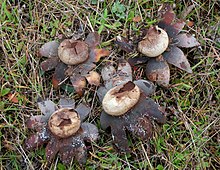| Astraeus pteridis | |
|---|---|

| |
| Scientific classification | |
| Domain: | Eukaryota |
| Kingdom: | Fungi |
| Division: | Basidiomycota |
| Class: | Agaricomycetes |
| Order: | Boletales |
| Family: | Diplocystaceae |
| Genus: | Astraeus |
| Species: | A. pteridis |
| Binomial name | |
| Astraeus pteridis (Shear) Zeller (1948) | |
| Synonyms | |
|
Scleroderma pteridis Shear (1902) | |
| Astraeus pteridis | |
|---|---|
| Glebal hymenium | |
| No distinct cap | |
| Hymenium attachment is not applicable | |
| Lacks a stipe | |
| Spore print is brown | |
| Ecology is mycorrhizal | |
| Edibility is inedible | |
Astraeus pteridis, commonly known as the giant hygroscopic earthstar, is a species of false earthstar in the family Diplocystaceae. It was described by American mycologist Cornelius Lott Shear in 1902 under the name Scleroderma pteridis. Sanford Myron Zeller transferred it to Astraeus in a 1948 publication. It is found in North America. A. pteridis was previously frequently confused with the supposedly cosmopolitan A. hygrometricus, now shown to be found only in Europe.
Distribution
A molecular phylogenetic study from 2013 resulted in the application of the name A. pteridis to the larger Astraeus found in the Pacific Northwest region of North America. A. pteridis has also been found in the Canary Islands, Madeira, and Argentina, which share historical connections to Lusitania. It may be widely distributed or have been translocated.
Morphology
A. pteridis closely resembles A. hygrometricus, though it is larger, reaching 5 to 15 cm (2.0 to 5.9 in) or more when expanded, and often has a more pronounced areolate pattern on the inner surface of the rays. Within Astraeus, A. pteridis is most closely related to A. morganii. Like other Astraeus, it is hygroscopic, with rays expanding in humid conditions and closing in arid conditions. It is not typically considered edible.
References
- "Astraeus pteridis (Shear) Zeller 1948". MycoBank. International Mycological Association. Retrieved 2011-08-30.
- Arora, David (1986). Mushrooms demystified: a comprehensive guide to the fleshy fungi (Second ed.). Berkeley: Ten Speed Press. ISBN 978-0-89815-169-5.
- Shear CL. (1902). "Mycological notes and new species". Bulletin of the Torrey Botanical Club. 29 (7): 449–57. doi:10.2307/2478544. JSTOR 2478544.
- Zeller SM. (1948). "Notes on certain Gasteromycetes, including two new orders". Mycologia. 40 (6): 639–68. doi:10.2307/3755316. JSTOR 3755316. PMID 18102856.
- Phosri, Cherdchai; Martín, María P.; Watling, Roy (Dec 2013). "Astraeus: hidden dimensions". IMA Fungus. 4 (2): 347–356. doi:10.5598/imafungus.2013.04.02.13. ISSN 2210-6340. PMC 3905946. PMID 24563840.
- Arora, David (1986). Mushrooms demystified : a comprehensive guide to the fleshy fungi (2nd ed.). Berkeley: Ten Speed Press. p. 706. ISBN 978-0898151701. OCLC 13702933.
External links
| Taxon identifiers | |
|---|---|
| Astraeus pteridis | |
| Scleroderma pteridis | |